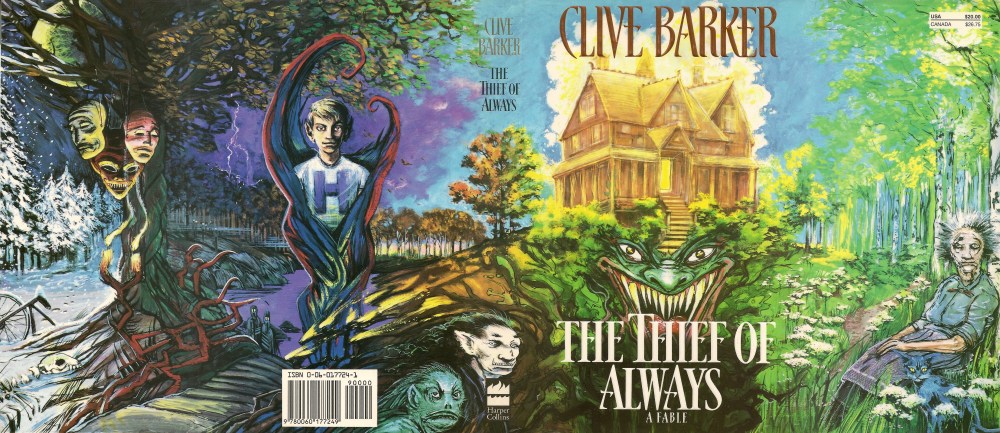
The Thief of Always is a children’s novel by Clive Barker. First published in 1992, it tells the tale of 10-year-old Harvey Swick who on one rainy evening is visited by an entity named Rictus who later lures him away to a place called Holiday House.
(Warning: spoilers follow.)
.
.
.
.
The house is actually the manifestation of a sorcerer called Hood who lures lonely, bored, and abandoned children into his realm. For every day that passes at the Holiday House, a year passes in the real world, and once a lifetime has passed outside, the children within undergo an Innsmouth-style transformation into hideous fish. Once they’ve turned, Hood claims their souls and slowly consumes them.
As compared with Neil Gaiman’s The Graveyard Book, I was impressed with Barker’s willingness to not pull many punches with regard to the peril he puts his young protagonists in. His willingness isn’t particularly surprising given the extreme horror of his adult fiction, but nonetheless, other authors might have taken a safer road here.
Barker sets a theme of devouring with the very first line of the book: “The great gray beast February had eaten Harvey Swick alive.”
And once young Harvey is inside the house, he’s greeted with a feast: “Mrs. Griffin had set a dozen plates of food in front of him: hamburgers, hot dogs and fried chicken; mounds of buttered potatoes; apple, cherry and mud pies, ice cream and whipped cream; grapes, tangerines and a plate of fruits he couldn’t even name.”
The hungry house offers plenty of illusory food for the children Hood has snared. But soon Barker deftly foreshadows both the dangers of the feast and the dangers to the children via the over-the-top demise of Clue-Cat:
He hoisted himself up onto the rim of the pan to sniff at its contents, his tail flicking back and forth. The next moment, disaster. The tail danced too close to one of the burners and burst into flames. Clue-Cat yowled, and tipped over the pan he was perched upon. A wave of boiling water washed him off the top of the stove, and he fell to the ground in a smoking heap. Whether drowned, scalded or incinerated, the end was the same: he hit the floor dead.
I was really quite surprised by this scene, because the standard advice pretty much everyone gives to writers of commercial fiction is that you never harm a young child or an adorable pet. And if you do, you have the death happen off-stage in order to protect the reader’s delicate sensibilities. But here, Barker kills Clue-Cat on stage, and with boiling water, no less! The gloves, clearly, are off as far as the kids are concerned.
And Barker doesn’t disappoint in later scenes. Harvey temporarily becomes a vampire and very nearly murders his friend Wendell. He witnesses Lulu’s hideous transformation, and can’t stop it. And there’s even more genuine horror in the scene in which he and Wendell are nearly killed by a creature called the Carna:
Harvey glanced back the way he’d come, more afraid not to know how close the creature was than to see it, however terrifying the sight. A veil of mist swirled in front of him, but he glimpsed Carna’s form as the beast descended. It was the most monstrous of the brood: its skin rotted and stretched over barbed and polished bone, its throat a nest of snaky tongues, its jaws set with hundreds of teeth.
There’s more real horror before the final confrontation with Hood that, at last, sets everything right and restores all the captured children’s souls and sends them back to their proper homes. Even Barker isn’t going to tamper with the requisite happy ending! (Although he does deviate from expectations somewhat in that Harvey and Lulu do not end up together at the end.)
Barker almost certainly pushed the horror content further than most children’s authors would feel comfortable with. But his book was well received nonetheless, and I found it to be a more rewarding reading experience than The Graveyard Book because Barker was able to maintain more tension in his narrative. And for my own purposes as a writer, it’s useful to see how a successful horror author was able to work within the boundaries of literature for younger readers.
Leave a Reply
You must be logged in to post a comment.